Hawk Green CC - A Cartledge Operation

The village of Hawk Green lies on the eastern edge of the urbanisation of Greater Manchester, in the Marple region of Stockport in old Cheshire, twelve miles north of Macclesfield and close to the border with Derbyshire.
The village cricket club was founded in 1909, joining the High Peak League the same year. They moved from their original ground, adjacent to Marple Golf Club, in the mid-1920s when the golf club purchased the land. Their new ground was the village green itself, opposite The Crown public house.
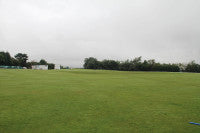
Moving into the 21st century, and with a new clubhouse/pavilion, courtesy of a 'mystery' fire which all but destroyed the old one, the club plays host to many local organisations including the Residents Association, and Slimmers World, and provides a venue for weddings and other functions.
This is a true 'volunteer' run club, with the current organisation being undertaken by chairman and groundsman, Roy Cartledge, who came to the club in 1990 having previously been at Birch Vale Cricket Club, together with the other officers of the club, underpinned by Management, Social and Junior committees.

"One of our members had heard of a professional groundsman, P. M. Phillips, who was the head man at Rolls Royce in Crewe, having previously held a similar post at Sophia Gardens in Cardiff. So we sought his advice and the end result was a square dressed with Surrey loam. I think this was the first loam the square had ever seen!"
"My ongoing 'training' started at this point and I attended seminars and talked to professional groundsmen, including Pete Marron at Old Trafford, to gain as much knowledge as I could," continues Roy.
At this point in time, Roy was also Chairman of the Derbyshire and Cheshire Cricket League and, with his better understanding of what was required to prepare and maintain a cricket wicket, set about organising seminars and demo days for the local league's groundsmen, in the process getting all of them to both understand and convert to proper loam wickets.
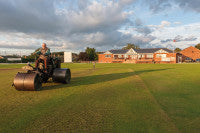
Roy's move to Hawk Green came at the suggestion of a particularly good friend who had been pestering him to join the club. "In my capacity as chairman I often attended meetings and, during one of these, he suggested I moved to Hawk Green as a first team player and groundsman. I looked at my current situation and decided that, with not many playing years left and the apparent apathy within my current club, it would be best for both of us if I moved on, especially with the prospect of a new challenge on, basically, a better ground."
"I told Birch Vale that, at the end of the 1989 season, I would sort out their autumn renovations and then be leaving, and that's what happened."
"When I arrived at Hawk Green the pitch was poor, although I shouldn't say that really, should I? There was an elderly chap who had done it for many years. With somewhat limited knowledge, when they first tried to put loam on, they used a wheelbarrow and a shovel and threw it about. So, it was a little bit 'up and down' to say the least."
"They were using a basic Mendip loam so, not long after, I upgraded to Boughton Club, and eventually to Boughton County Loam, to give a harder finish to the surface with better pace and bounce. I was being told that loam might affect grass growth but, following my training, I never had too many problems. However, with the autumn, winter and spring weather prior to this season, nothing germinated.
As the years rolled by and Roy's playing days became but a memory, he continued his role as groundsman and also took over the chairmanship of the club.
The square originally had thirteen tracks, but this has been increased to fifteen to accommodate a thriving junior section, by very heavy scarifying on one end of the square to make a new pitch and setting out all the existing pitches at nine feet centres.
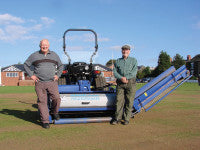
"I thought it was my birthday when he arrived with a Koro Field Topmaker fitted with the Terraplane blades. This is a newly developed rotor I had seen demonstrated earlier in the year. Peter Marron, former head groundsman at Lancashire CCC, believes all sports grounds should be 'koroed off'."
"Once the Koro had done its work, by planing off the top to leave a flat surface, removing any thatch or debris, but leaving the root structure intact, the surface was then mechanically raked to create a tilth and then fertilised with pre-seed and, finally, dressed with approximately two tonnes of Boughton County loam. I can't wait to see the final result and produce a track!"
"I try to keep costs down to a minimum," continues Roy. "As chairman, I am acutely aware of our finances. However, I normally have a free hand, and give the committee an estimate of the costs."

"I regularly attend meetings of the Cheshire Association of Groundsmen, (CAG), and we arrange occasional visits, most recently to Old Trafford where, this year, they had bare areas on their square! That made me feel a lot better about having them on mine!" Roy says with a smile.
"Due to the number of fixtures we now play across all age levels, each track will get used at least four times, and often five, so it's hardly surprising there are a few bare patches."
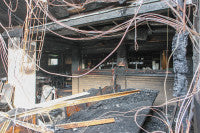
"When I arrived at the ground, the fire had really taken hold," says Roy. "It was just awful to see. All our history up in flames!"
"To this day, we don't know what caused it. The fire service and police forensics suspected foul play, but no evidence was ever found. We have an idea ourselves of what could have happened, but that is only supposition."
"We claimed on the insurance and, typically, they did their level best to give us as little as possible, as you might expect. For the following two seasons we had a big marquee at the other end of the ground, and we also managed to get hold of portable toilets for males and females which we situated out of sight. We just had to make do really. The members were brilliant and all rallied round to help."
"The ECB had their own guidelines as to the requirements for the pavilion, but were really helpful and awar
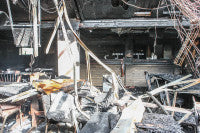
"In hindsight, what we should have done was flatten the old building and start afresh because, in reality, it was only the back wall that was eventually left standing. Over the eighteen months that it took to sort the finances, the condition of the building had only got worse. The new building was more or less designed on the same basic layout as the original and retained the old back wall. The new clubhouse was eventually finished during the 2010 season."
"A few years prior to the fire, we had an extension built to improve facilities and make the changing rooms larger, so that was incorporated into the new building. But it took an age to build," bemoans Roy. "Over twelve months."

"That was a very successful event," says Roy, happily. "We had over 1,000 spectators on the day which certainly added to the club's coffers, as well as giving them the chance to see some real stars of cricket."
"It was a fairly complex process to get them," explains Roy. "We firstly had to finish in the top ten of an on-line poll, where we actually finished third. We then had to submit a report explaining what we were planning to do with any money we made. We obviously mentioned the fire and our strong juniors section, plus our plans for a new scoreboard (which has been vandalised). To our delight we were awarded one of only three matches, but with only about four weeks to organise it!"

With the clubhouse now back open, has there been an influx of members?
"Maybe at first. We have always tended to have our regulars, and also the juniors night on Friday, which is very popular. I would like to think Martyn [Roy's son] and I started this. We did it for about two or three years, but it got to the point that, unless we got some help, we would have to turn kids away. There were just too many. It was nearly at the point where it was used as a creche. Parents would use the bar area whilst the kids were looked after elsewhere."
"Fortunately," Roy continues, "we now have quite a few coaches to help out, including my grandson, whereas it used to be just Martyn and I. We recently sent two ladies on the ECB coaching course and we aim to get even more on it. We now have an excellent separate junior committee, and are seeing a big improvement in our junior set-up."
"Our juniors have been pretty successful this year. The U-17s lost in their cup final. The U-15s eventually won their competition, played on our ground after rain postponed the final, and the U-13s actually won their section."
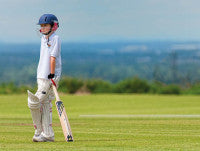
"We still get a good turnout on a Friday evening, but things have changed. People used to come for a night out and have a burger but, since the fire, that has changed. We don't get as many as we did before. Perhaps the economic climate is to blame as well."
"We have around sixty registered junior members, with a regular turnout of between thirty and forty, so we are fairly pleased with that. A lot of those are quite young and some certainly have the potential to be good cricketers."
Roy's passion for all things cricket is admirable and this is evident when looking at the ground. "Presentation is really important to me," he stresses. "I believe that, if it looks good, then everyone thinks it plays good. Conversely, if a wicket looks bad, even if it is superb, players think it is rubbish and treat it as such. If the outfield is nicely cut, again any failings are not highlighted."
"The problem is, I'm not getting any younger. My mate Roy is brilliant with maintenance of the machinery. He's especially good at all things mechanical, but he is even older than me, so I'm going to need some help. There were a couple of players who showed an interest, but nothing has transpired yet. The problem is that most people think this is just a Friday evening job, and they don't understand the work involved. When they do, it frightens them off!"
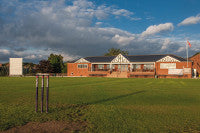
At this point, you may be wondering why Roy's son Martyn doesn't help out, but as he himself explains; "I can't, due to illness, which showed up whilst I was playing. These days, juniors are not allowed to bowl too many overs but, back when I started, I was just bowling all the way through, so that probably didn't help with the back problems I suffer from now. That was before they knew that juniors could 'do too much'. So, now I can't even play, let alone help dad out."
Roy continues; "Each year we spend around £1,000 on loam, seed, fertiliser and weedkiller and, with a contractor carrying out this year's end of season renovations, that's an additional expense. Hopefully though, the club will see the benefits next season."

"We do have two big flat sheets but, again, we can't handle them. You need eight people to move them. My other main problem is that the square is on a slope. According to an old drawing I found, it says that the pitch is on a twelve inch slope end to end and four feet across the square. Water just runs down it and saturates one end! Having said all that, the square has, touch wood, been playing fine."
What did England Legends have to say about it? "They were delighted. In fact, they chose the wicket they wanted to play on. I had prepared a couple of wickets and told them that one was a tad thatchy and one was a bit firmer. They looked at them both, bounced a ball on them and then made their choice."
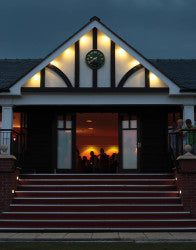
"We tend to buy our equipment either new or nearly new," states Roy. "Basically from what funds we have and what grants might be available. If I had a wish list it would include a dedicated cricket roller, a mechanical vertical spiker and a waterhog - in fact, anything the county boys have!"
Other projects Roy has busied himself with include revamping the practice area, with a permanent net around the artificial, and added a grass practice area alongside, which was laid from scratch.
Roy is typical of the volunteers that keep grassroots cricket alive. Even in his advancing years he remains totally committed to his club, but has one passing aside. "Our membership fees are £30. That's the cheapest in the league by a long way. Even then, they will argue that they have to pay to get into the hundred club and want free entry because they pay their membership!"
That, in a nutshell, is the culture that needs to change.

What's in the shed?
Dennis 520 with cassette attachments
Toro triple outfield mower
Tractor unit with rotary cutting deck and brush unit
Heavy roller - old Aveling Barford, but with modern diesel engine
Sisis Hydromain (old), with spiker, autoseeder and sarrel roler attachments
Hand operated spinner spreader
Sisis belt spreader
Walkman sprayer
Sisis Trulute
